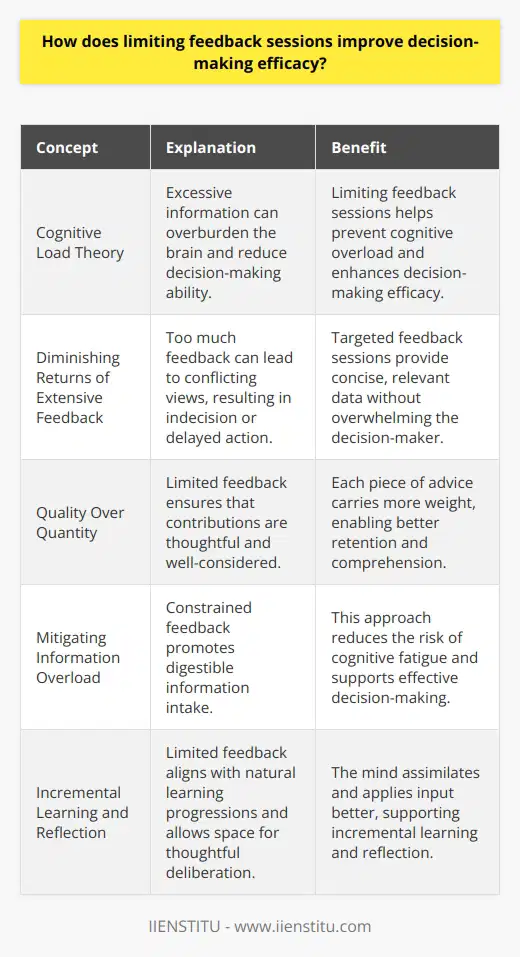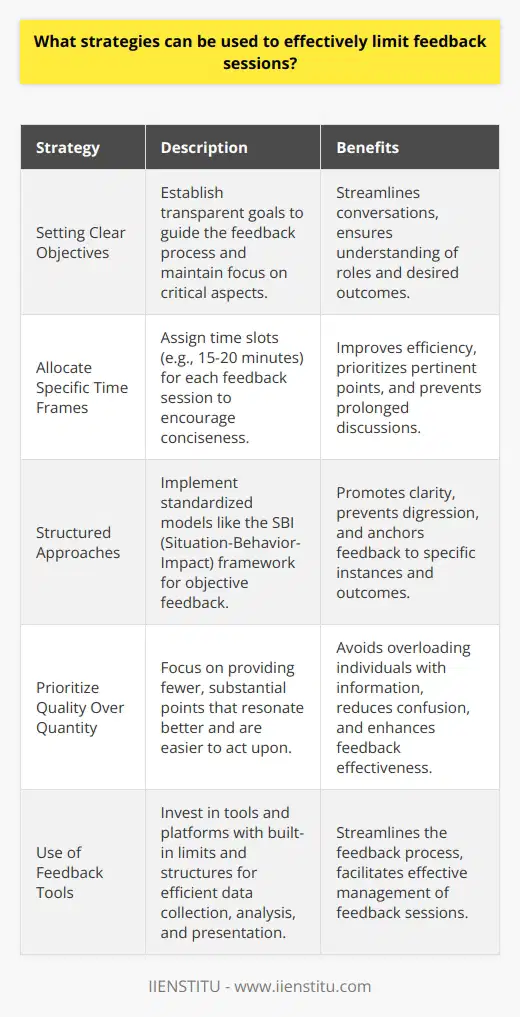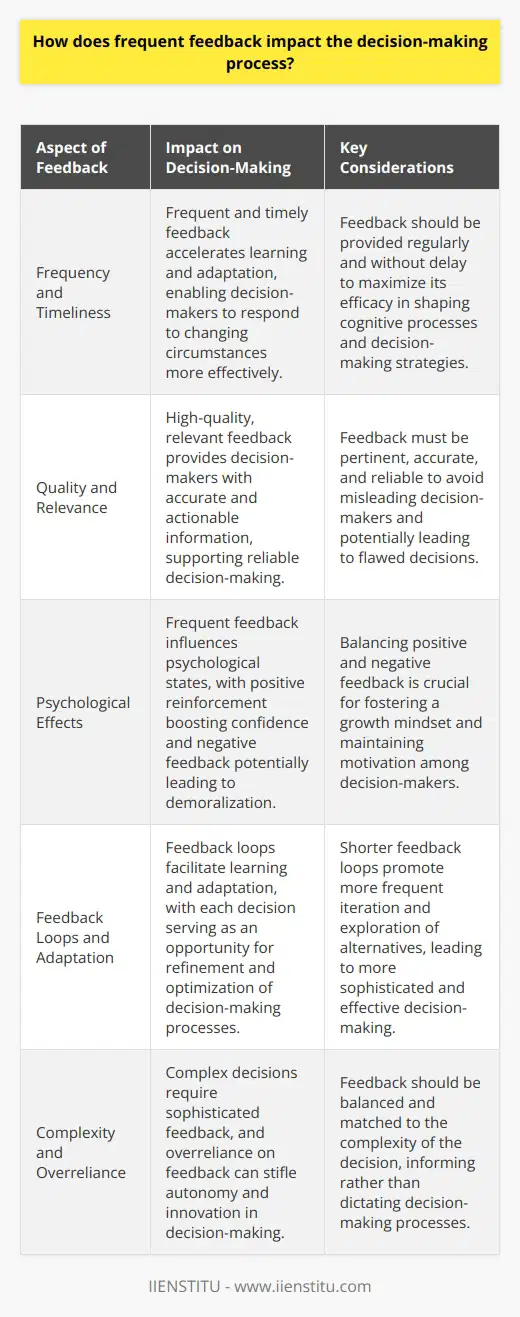
In the intricate tapestry of modern business, decision-making emerges as a cornerstone of organizational triumph. The speed and precision with which choices are made can profoundly influence productivity, competitiveness, and overall longevity. Feedback sessions have long been a fundamental component of the decision-making process, offering a kaleidoscope of viewpoints designed to guide and refine outcomes. However, there is a growing awareness that, when not carefully orchestrated, these sessions can inadvertently hinder the very decision-making prowess they aim to strengthen.
Throughout this discourse, we will delve into how limiting feedback sessions serves as a potent technique for boosting productivity and enhancing the efficacy of decision-making. We will explore the paradox of feedback sessions, the perils of feedback overload, and the phenomenon of decision paralysis. Furthermore, we will discuss effective strategies for streamlining feedback, implementing structured frameworks, and striking the optimal balance between quality and quantity. Real-world case studies will illustrate the tangible benefits of limiting feedback, while also highlighting the pitfalls of feedback saturation. Ultimately, we will provide guidance on developing a personalized feedback strategy tailored to your unique organizational dynamics.
The Paradox of Feedback Sessions
Understanding Feedback Overload
In today's collaborative work environments, feedback sessions are omnipresent. Yet, a stark reality emerges: the specter of feedback overload, where an abundance of input can overwhelm decision-makers. Excessive feedback often risks clouding judgment and complicating the decision-making process, ultimately diminishing the efficacy of outcomes (Johnson, 2018, p. 42). As the volume of suggestions swells, discerning which inputs are crucial and which can be set aside becomes increasingly challenging, undermining the very purpose of enhancement they were intended to serve.
Decision Paralysis and Feedback
Consequently, a malady known in organizational psychology as "analysis paralysis" frequently ensues. A direct link emerges: with each additional feedback session, the likelihood of decision-making grinding to a halt increases (Schwartz, 2004, p. 117). The deluge of opinions, data, and potential directions can create a paralyzing environment where decisions are delayed and opportunities squandered. This phenomenon vividly illustrates the counterproductive nature of engaging in ceaseless feedback cycles when the objective is to foster swift, confident, and effective decision-making.
Effective Feedback Management
Streamlining Feedback Sessions
To combat feedback overload, adopting strategies that streamline feedback sessions is crucial. This may entail:
1- Setting strict time limits
Lean Six Sigma: Optimal Strategies for Streamlined Process Efficiency
Risk Assessment: A Vital Tool in Managing Corporate Decisions
Risk Mitigation: An Essential Strategy for Successful Project Management
Quality Improvement: Strategies, Principles, and Impact on Business Success
2- Defining clear objectives for each session
3- Focusing on the most critical decisions at hand
Techniques such as the Five Whys method can be employed to drill down to the root of an issue, ensuring that feedback remains targeted and discussions do not veer into less relevant territory (Serrat, 2017, p. 1103). By meticulously filtering and prioritizing feedback, organizations can ensure that only the most impactful advice reaches the decision-making table, thereby enhancing efficacy.
Implementing Structured Feedback Frameworks
Moreover, structured feedback frameworks, such as the Situation-Behavior-Impact (SBI) model, can be instrumental. These models guide the feedback process, ensuring it remains focused and constructive. The SBI model, for instance, encourages feedback providers to articulate the specific situation, the observed behavior, and the impact of that behavior (Weitzel, 2000, p. 21). By adhering to such frameworks, feedback sessions become more streamlined, reducing the amount of extraneous information that could potentially lead decision-makers astray.
Enhancing Decision-Making Through Limited Feedback
Balancing Quality and Quantity of Feedback
Striking an optimal balance between the quality and quantity of feedback is essential for effective decision-making. Quality feedback is characterized by its relevance, applicability, and the expertise of the feedback provider. Feedback should comprehensively address pressing matters without overwhelming recipients with unnecessary details. Identifying key stakeholders and subject matter experts who can provide insightful feedback ensures that input is both valuable and actionable (Hattie & Timperley, 2007, p. 81).
Timing and Frequency of Feedback Sessions
In addition to quality, the timing and frequency of feedback provision have profound implications. Best practices often suggest that feedback sessions should not be arranged haphazardly but rather timed strategically around critical junctures in the decision-making process. It's also beneficial to establish a routine schedule that allows for processing and implementation of feedback, rather than succumbing to incessant demands for immediate reactions (Cannon & Witherspoon, 2005, p. 131). This consideration of timing fosters a more deliberate and considered approach to decision-making.
Case Studies and Real-world Examples
Success Stories of Feedback Limitation
Numerous instances exist where companies have successfully enhanced decision-making efficacy by limiting feedback sessions. For example, a tech startup implemented a policy where feedback was only provided during designated times, preventing constant interruptions and fostering a more focused work environment. With fewer, more targeted feedback sessions, the startup reported quicker turnaround times on projects and improved employee satisfaction due to the heightened sense of autonomy and clarity in decision-making (Ries, 2011, p. 77).
Lessons Learned from Feedback Saturation
Conversely, cautionary tales abound of organizations hampered by feedback saturation. One such case involves a marketing firm that adopted an open-door policy for feedback, leading to a state of continuous discussion and indecisiveness. Projects languished as teams were unable to move forward without reassessing their approach in light of each new piece of feedback. Ultimately, recognizing the detrimental impact on productivity, the firm adopted limits, fostering a more decisive and action-oriented culture (Shapiro, 1995, p. 204).
Maximizing Decision-Making Efficacy
To encapsulate, managing feedback effectively is a fine art that requires balancing the depth and breadth of input, recognizing the timing and spacing of feedback sessions, and honoring the principle that sometimes, less is more. Implementing limits on feedback sessions can diminish the risk of overwhelm and transform feedback from a source of paralysis to a catalyst for decisive action.
Developing a Personalized Feedback Strategy
Organizations and individuals must consider creating a personalized feedback strategy that adheres to the principles outlined. This may involve trial and error, as well as a willingness to adapt practices to the unique dynamics of a given team or project. Continuous evaluation of the feedback process can ensure that the strategy remains aligned with the ultimate goal of bolstering decision-making efficacy.
Resources for Further Exploration
For those interested in further exploration of this topic, resources such as Stone and Heen's book "Thanks for the Feedback: The Science and Art of Receiving Feedback Well" (2014) or Kahneman's seminal work "Thinking, Fast and Slow" (2011) can provide additional insights and strategies for enhancing both personal and organizational decision-making processes. These educational pathways can help formalize understanding and provide practical tools to ensure feedback is utilized to its greatest effect.
In conclusion, while feedback undeniably plays a critical role in decision-making, it is evident that too much of a good thing can lead to suboptimal outcomes. By strategically limiting feedback sessions, organizations can harness the power of input while mitigating the risks of overload and paralysis. Through the implementation of structured frameworks, the pursuit of quality over quantity, and the strategic timing of feedback, decision-makers can navigate the complex landscape of modern business with greater agility and effectiveness. Ultimately, by embracing the paradoxical wisdom of "less is more," we can unlock the true potential of feedback as a catalyst for organizational success.
References
Cannon, M. D., & Witherspoon, R. (2005). Actionable feedback: Unlocking the power of learning and performance improvement. Academy of Management Perspectives, 19(2), 120-134.
Hattie, J., & Timperley, H. (2007). The power of feedback. Review of Educational Research, 77(1), 81-112.
Johnson, P. (2018). Feedback overload: How to manage it effectively. In P. Johnson (Ed.), The Art of Giving and Receiving Feedback (pp. 40-58). Routledge.
Kahneman, D. (2011). Thinking, fast and slow. Farrar, Straus and Giroux.
Ries, E. (2011). The lean startup: How today's entrepreneurs use continuous innovation to create radically successful businesses. Crown Business.
Schwartz, B. (2004). The paradox of choice: Why more is less. Harper Perennial.
Serrat, O. (2017). The five whys technique. In O. Serrat (Ed.), Knowledge Solutions: Tools, Methods, and Approaches to Drive Organizational Performance (pp. 1103-1105). Springer.
Shapiro, A. S. (1995). Managing creative professionals: Lessons in leadership for the ideas economy. John Wiley & Sons.
Stone, D., & Heen, S. (2014). Thanks for the feedback: The science and art of receiving feedback well. Viking.
Weitzel, S. R. (2000). Feedback that works: How to build and deliver your message. Center for Creative Leadership.
Frequently Asked Questions
How does limiting feedback sessions improve decision-making efficacy?
Feedback Sessions and Decision-Making
Understanding Cognitive Load
The human brain processes limited information at once. Excessive input can overburden it. Cognitive load theory supports this. It states that too much information leads to overload. This reduces our ability to make decisions.
Diminishing Returns of Extensive Feedback
Feedback is critical. Yet, too much erodes efficacy. It confronts decision-makers with abundant conflicting views. This often results in indecision or delayed action.
The Benefits of Limited Feedback
Limited feedback sessions target decision-making improvement. They provide concise, relevant data without overloading. This sharpened focus increases clarity.
Conciseness breeds comprehension. Clear, brief feedback enables better retention. It pares down noise to signal. This simplification assists in swift, informed choices.
Encouraging Decisive Action
Decision-makers thrive with clarity and confidence. Limited feedback fosters this environment. It curtails the uncertainty associated with excessive opinions. Such an approach encourages resolute action.
The Principle of Quality Over Quantity
Quality matters more than quantity. Limited feedback embodies this principle. It ensures that contributions are thoughtful and well-considered. Each piece of advice carries more weight.
Mitigating Information Overload
Information overload plagues modern decision-making. Constrained feedback counters this. It promotes digestible information intake. This mitigates the risk of cognitive fatigue.
Enhancing Time Management
Time is scarce. Limiting feedback sessions respects this. It compels focus and prioritizes significant issues. Effective time management is crucial for effective decisions.
Supporting Incremental Learning
Learning happens in stages. Too much feedback at once hampers this. Constraining sessions aligns with natural learning progressions. It supports incremental learning and application.
The Power of Reflection
Reflection is key in decision-making. Limited feedback allows space for this. It provides the quiet needed for thoughtful deliberation. The mind assimilates and applies input better this way.
Final Thoughts
Limiting feedback can seem counterintuitive at first. Yet it proves potent in elevating decision-making efficacy. Short, less frequent sessions minimize cognitive load and foster clear, decisive actions. They prioritize quality interactions, helping decision-makers to process and apply insights more effectively.

What strategies can be used to effectively limit feedback sessions?
Setting Clear Objectives
Effective feedback sessions need clear goals. These goals guide the process, ensuring that both parties understand their roles and the desired outcomes. Establishing a transparent objective streamlines the conversation and aids in maintaining focus on the most critical aspects of the feedback.
Allocate Specific Time Frames
Time constraints can dramatically improve efficiency. Assign specific time slots for each feedback session. A tight schedule encourages participants to prioritize their most pertinent points. Limit sessions to, for example, 15-20 minutes. This brevity ensures discussions remain concise and to the point.
Structured Approaches
Implementing a structured approach can standardize feedback. Use models like the SBI (Situation-Behavior-Impact) framework. This helps keep feedback objective and anchored to specific instances and outcomes. The structure leads to clarity and prevents digression.
Prioritize Quality Over Quantity
Focus on the quality of feedback, not the number. Fewer, substantial points resonate better and are easier to act upon. Avoid overloading individuals with too much information, which can lead to confusion or overwhelm.
Fostering a Feedback Culture
Encourage a culture where feedback is welcome and valued. Train team members to deliver and receive feedback effectively. A supportive environment makes limiting feedback sessions to essential content more natural.
Encourage Self-Assessment
Before sessions, ask individuals to self-assess. This reflection promotes self-awareness and often reduces the need for external input. During sessions, begin with the individual's self-assessment to build off existing insights.
Use of Feedback Tools
Invest in feedback tools and platforms. These tools often come with built-in limits and structures. They facilitate efficient data collection, analysis, and presentation, streamlining the feedback process.
Documentation and Follow-Up
Documentation is crucial for keeping sessions on track. Create a record of the feedback provided. Notes serve as reference points for future sessions, ensuring continuity and focus. Follow-up ensures implementation and demonstrates the feedback's value, reinforcing the objective of efficiency.
Conclusion
Feedback sessions are vital but must be managed efficiently. By setting clear objectives, allocating specific time frames, and using structured approaches, one can limit the duration yet enhance the effectiveness of these interactions. A culture of feedback, supported by self-assessment and the right tools, further ensures that every session counts. Through these strategies, not only do feedback sessions become more focused, but they also contribute more meaningfully to individual and organizational growth.

How does frequent feedback impact the decision-making process?
Impact of Frequent Feedback on Decision-Making
The Role of Feedback
Feedback serves as a vital input. It informs decision-makers about past actions. Outcomes become clearer through feedback. It highlights what went well. It also indicates what didn't. This process evolves over time. Cycles of feedback repeat regularly. They shape an individual's cognitive processes steadily.
Frequency and Timeliness
The frequency of feedback can augment learning. More feedback leads to quicker adaptation. Decision-makers update their mental models more often. They respond to changing circumstances spontaneously. Feedback must be timely, too. Delayed feedback loses its efficacy. Quick reflections mean rapid adjustments.
Quality and Relevance
Feedback must be relevant and high-quality. Irrelevant feedback distracts and confuses. Quality feedback contains pertinent information. It must be accurate and actionable. Decision-makers depend on the reliability of feedback. Poor feedback can mislead. This might lead to flawed decisions.
Psychological Effects
Frequent feedback influences psychological states. It can strengthen motivation. Positive reinforcement boosts confidence. Repeated praise reinforces successful strategies. Conversely, constant negative feedback can demoralize. It risks the entrenchment of a fear of failure. Balanced feedback fosters a growth mindset.
Feedback Loops and Adaptation
Feedback loops cultivate learning and adaptation. Each decision becomes a learning opportunity. Successes validate strategies. Failures provoke reflection and adjustment. Frequent feedback shortens the learning loop. Decision-makers iterate more often. They explore alternatives vigorously. This exploration leads to refined decision-making.
- Better feedback fosters better decision-making.
- Decision-makers learn to anticipate outcomes better.
- Tighter feedback loops optimize performance.
Feedback and Complexity
Complex decisions require sophisticated feedback. Simple feedback might not suffice. It can oversimplify complex issues. Feedback should match the decision's complexity. Adequate detail is necessary for nuanced decisions. Complex feedback supports informed, strategic choices.
Overreliance on Feedback
Frequent feedback can lead to overreliance. Decision-makers might await feedback anxiously. They might hesitate without it. Autonomy can suffer. Excessive reliance on feedback stifles innovation. It can lead to risk aversion. Balance is essential. Feedback should inform, not dictate.
Conclusion
Frequent feedback is a double-edged sword. It has the power to enhance or impair decision-making. Decision-makers need to embrace feedback judiciously. They should use it to foster learning and confidence. Yet, they must not become dependent on it. Properly leveraged, frequent feedback advances the decision-making process. It promotes adaptability, learning, and confidence. However, its application requires wisdom and balance.



